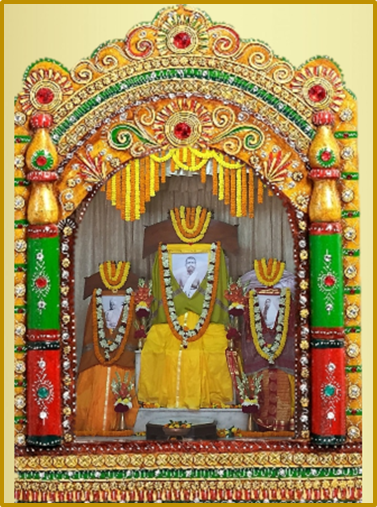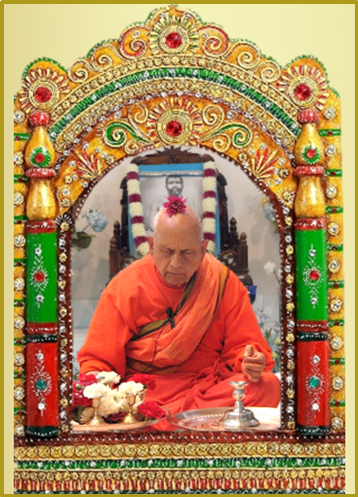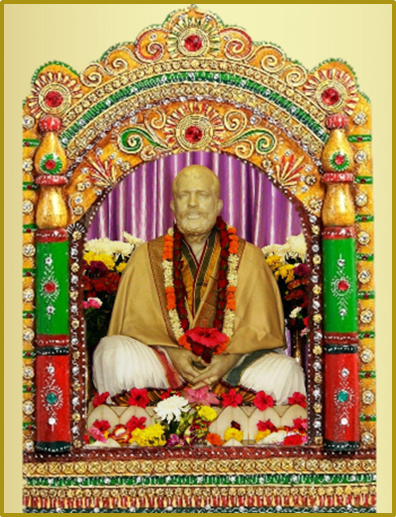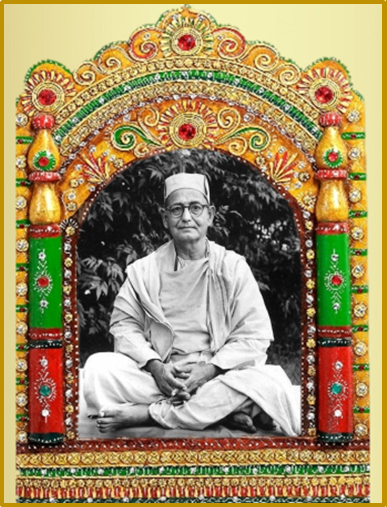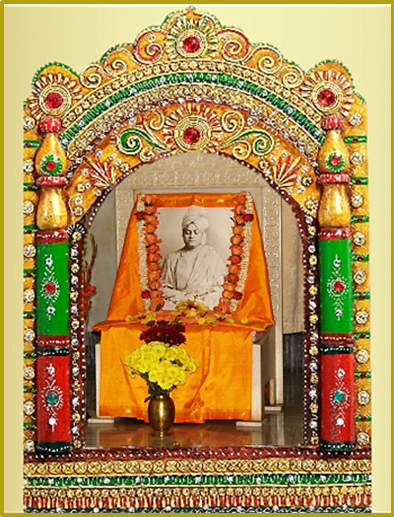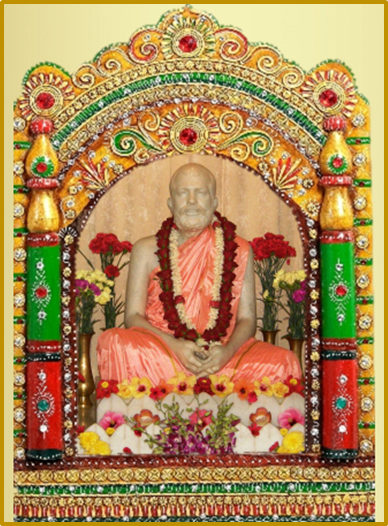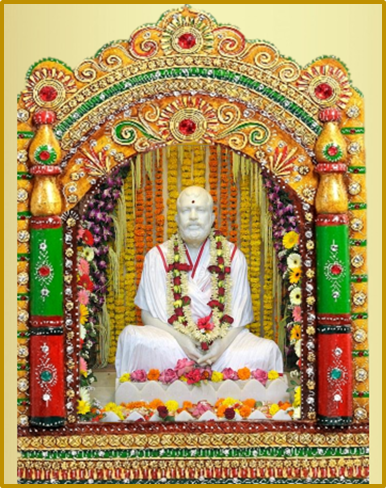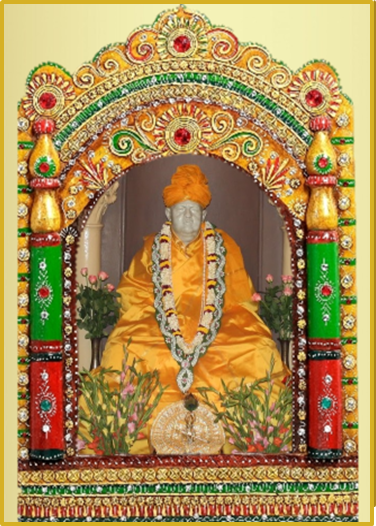“When should I attend to my morning, noon and evening service? The sun is shining in the sky of my heart. It does not rise. It does not set.” - (Upanishads)
When the necessary mental purification has been attained by the aspirant, rituals are no longer of any use. There are people who renounce rituals before they are sufficiently developed. This is very wrong, just as renouncing image worship before having outgrown it, is very wrong and very harmful. Never decry people who worship images. There is a great truth in image-worship and the Protestants are quite wrong in denying it. They do not know anything of spiritual traditions and spiritual life. There is not only subjective but also objective manifestation in the holy image. This, too, is the idea standing at the back of the Roman Catholic forms of worship, however distorted they may have become in course of time. For most of us, worship of some image, physical or mental, is absolutely necessary if we really wish to grow, and not merely to theorize. The idea of the formless etc.,
{"id":92,"name":"On The Gospel of Sri Ramakrishna","pages":[{"title":"page 1","src":"http:\/\/surbhi.info\/wp-content\/uploads\/real3dflipbook\/On The Gospel of Sri Ramakrishna - Swami Yatiswarananda\/page1.jpg","thumb":"http:\/\/surbhi.info\/wp-content\/uploads\/real3dflipbook\/On The Gospel of Sri Ramakrishna - Swami Yatiswarananda\/thumb1.jpg","htmlContent":""},{"title":"page 2","src":"http:\/\/surbhi.info\/wp-content\/uploads\/real3dflipbook\/On The Gospel of Sri Ramakrishna - Swami Yatiswarananda\/page2.jpg","thumb":"http:\/\/surbhi.info\/wp-content\/uploads\/real3dflipbook\/On The Gospel of Sri Ramakrishna - Swami Yatiswarananda\/thumb2.jpg","htmlContent":""},{"title":"page 3","src":"http:\/\/surbhi.info\/wp-content\/uploads\/real3dflipbook\/On The Gospel of Sri Ramakrishna - Swami Yatiswarananda\/page3.jpg","thumb":"http:\/\/surbhi.info\/wp-content\/uploads\/real3dflipbook\/On The Gospel of Sri Ramakrishna - Swami Yatiswarananda\/thumb3.jpg","htmlContent":""},{"title":"page 4","src":"http:\/\/surbhi.info\/wp-content\/uploads\/real3dflipbook\/On The Gospel of Sri Ramakrishna - Swami Yatiswarananda\/page4.jpg","thumb":"http:\/\/surbhi.info\/wp-content\/uploads\/real3dflipbook\/On The Gospel of Sri Ramakrishna - Swami Yatiswarananda\/thumb4.jpg","htmlContent":""},{"title":"page 5","src":"http:\/\/surbhi.info\/wp-content\/uploads\/real3dflipbook\/On The Gospel of Sri Ramakrishna - Swami Yatiswarananda\/page5.jpg","thumb":"http:\/\/surbhi.info\/wp-content\/uploads\/real3dflipbook\/On The Gospel of Sri Ramakrishna - Swami Yatiswarananda\/thumb5.jpg","htmlContent":""},{"title":"page 6","src":"http:\/\/surbhi.info\/wp-content\/uploads\/real3dflipbook\/On The Gospel of Sri Ramakrishna - Swami Yatiswarananda\/page6.jpg","thumb":"http:\/\/surbhi.info\/wp-content\/uploads\/real3dflipbook\/On The Gospel of Sri Ramakrishna - Swami Yatiswarananda\/thumb6.jpg","htmlContent":""},{"title":"page 7","src":"http:\/\/surbhi.info\/wp-content\/uploads\/real3dflipbook\/On The Gospel of Sri Ramakrishna - Swami Yatiswarananda\/page7.jpg","thumb":"http:\/\/surbhi.info\/wp-content\/uploads\/real3dflipbook\/On The Gospel of Sri Ramakrishna - Swami Yatiswarananda\/thumb7.jpg","htmlContent":""},{"title":"page 8","src":"http:\/\/surbhi.info\/wp-content\/uploads\/real3dflipbook\/On The Gospel of Sri Ramakrishna - Swami Yatiswarananda\/page8.jpg","thumb":"http:\/\/surbhi.info\/wp-content\/uploads\/real3dflipbook\/On The Gospel of Sri Ramakrishna - Swami Yatiswarananda\/thumb8.jpg","htmlContent":""},{"title":"page 9","src":"http:\/\/surbhi.info\/wp-content\/uploads\/real3dflipbook\/On The Gospel of Sri Ramakrishna - Swami Yatiswarananda\/page9.jpg","thumb":"http:\/\/surbhi.info\/wp-content\/uploads\/real3dflipbook\/On The Gospel of Sri Ramakrishna - Swami Yatiswarananda\/thumb9.jpg","htmlContent":""},{"title":"page 10","src":"http:\/\/surbhi.info\/wp-content\/uploads\/real3dflipbook\/On The Gospel of Sri Ramakrishna - Swami Yatiswarananda\/page10.jpg","thumb":"http:\/\/surbhi.info\/wp-content\/uploads\/real3dflipbook\/On The Gospel of Sri Ramakrishna - Swami Yatiswarananda\/thumb10.jpg","htmlContent":""},{"title":"page 11","src":"http:\/\/surbhi.info\/wp-content\/uploads\/real3dflipbook\/On The Gospel of Sri Ramakrishna - Swami Yatiswarananda\/page11.jpg","thumb":"http:\/\/surbhi.info\/wp-content\/uploads\/real3dflipbook\/On The Gospel of Sri Ramakrishna - Swami Yatiswarananda\/thumb11.jpg","htmlContent":""},{"title":"page 12","src":"http:\/\/surbhi.info\/wp-content\/uploads\/real3dflipbook\/On The Gospel of Sri Ramakrishna - Swami Yatiswarananda\/page12.jpg","thumb":"http:\/\/surbhi.info\/wp-content\/uploads\/real3dflipbook\/On The Gospel of Sri Ramakrishna - Swami Yatiswarananda\/thumb12.jpg","htmlContent":""},{"title":"page 13","src":"http:\/\/surbhi.info\/wp-content\/uploads\/real3dflipbook\/On The Gospel of Sri Ramakrishna - Swami Yatiswarananda\/page13.jpg","thumb":"http:\/\/surbhi.info\/wp-content\/uploads\/real3dflipbook\/On The Gospel of Sri Ramakrishna - Swami Yatiswarananda\/thumb13.jpg","htmlContent":""},{"title":"page 14","src":"http:\/\/surbhi.info\/wp-content\/uploads\/real3dflipbook\/On The Gospel of Sri Ramakrishna - Swami Yatiswarananda\/page14.jpg","thumb":"http:\/\/surbhi.info\/wp-content\/uploads\/real3dflipbook\/On The Gospel of Sri Ramakrishna - Swami Yatiswarananda\/thumb14.jpg","htmlContent":""},{"title":"page 15","src":"http:\/\/surbhi.info\/wp-content\/uploads\/real3dflipbook\/On The Gospel of Sri Ramakrishna - Swami Yatiswarananda\/page15.jpg","thumb":"http:\/\/surbhi.info\/wp-content\/uploads\/real3dflipbook\/On The Gospel of Sri Ramakrishna - Swami Yatiswarananda\/thumb15.jpg","htmlContent":""},{"title":"page 16","src":"http:\/\/surbhi.info\/wp-content\/uploads\/real3dflipbook\/On The Gospel of Sri Ramakrishna - Swami Yatiswarananda\/page16.jpg","thumb":"http:\/\/surbhi.info\/wp-content\/uploads\/real3dflipbook\/On The Gospel of Sri Ramakrishna - Swami Yatiswarananda\/thumb16.jpg","htmlContent":""},{"title":"page 17","src":"http:\/\/surbhi.info\/wp-content\/uploads\/real3dflipbook\/On The Gospel of Sri Ramakrishna - Swami Yatiswarananda\/page17.jpg","thumb":"http:\/\/surbhi.info\/wp-content\/uploads\/real3dflipbook\/On The Gospel of Sri Ramakrishna - Swami Yatiswarananda\/thumb17.jpg","htmlContent":""},{"title":"page 18","src":"http:\/\/surbhi.info\/wp-content\/uploads\/real3dflipbook\/On The Gospel of Sri Ramakrishna - Swami Yatiswarananda\/page18.jpg","thumb":"http:\/\/surbhi.info\/wp-content\/uploads\/real3dflipbook\/On The Gospel of Sri Ramakrishna - Swami Yatiswarananda\/thumb18.jpg","htmlContent":""},{"title":"page 19","src":"http:\/\/surbhi.info\/wp-content\/uploads\/real3dflipbook\/On The Gospel of Sri Ramakrishna - Swami Yatiswarananda\/page19.jpg","thumb":"http:\/\/surbhi.info\/wp-content\/uploads\/real3dflipbook\/On The Gospel of Sri Ramakrishna - Swami Yatiswarananda\/thumb19.jpg","htmlContent":""},{"title":"page 20","src":"http:\/\/surbhi.info\/wp-content\/uploads\/real3dflipbook\/On The Gospel of Sri Ramakrishna - Swami Yatiswarananda\/page20.jpg","thumb":"http:\/\/surbhi.info\/wp-content\/uploads\/real3dflipbook\/On The Gospel of Sri Ramakrishna - Swami Yatiswarananda\/thumb20.jpg","htmlContent":""},{"title":"page 21","src":"http:\/\/surbhi.info\/wp-content\/uploads\/real3dflipbook\/On The Gospel of Sri Ramakrishna - Swami Yatiswarananda\/page21.jpg","thumb":"http:\/\/surbhi.info\/wp-content\/uploads\/real3dflipbook\/On The Gospel of Sri Ramakrishna - Swami Yatiswarananda\/thumb21.jpg","htmlContent":""},{"title":"page 22","src":"http:\/\/surbhi.info\/wp-content\/uploads\/real3dflipbook\/On The Gospel of Sri Ramakrishna - Swami Yatiswarananda\/page22.jpg","thumb":"http:\/\/surbhi.info\/wp-content\/uploads\/real3dflipbook\/On The Gospel of Sri Ramakrishna - Swami Yatiswarananda\/thumb22.jpg","htmlContent":""},{"title":"page 23","src":"http:\/\/surbhi.info\/wp-content\/uploads\/real3dflipbook\/On The Gospel of Sri Ramakrishna - Swami Yatiswarananda\/page23.jpg","thumb":"http:\/\/surbhi.info\/wp-content\/uploads\/real3dflipbook\/On The Gospel of Sri Ramakrishna - Swami Yatiswarananda\/thumb23.jpg","htmlContent":""},{"title":"page 24","src":"http:\/\/surbhi.info\/wp-content\/uploads\/real3dflipbook\/On The Gospel of Sri Ramakrishna - Swami Yatiswarananda\/page24.jpg","thumb":"http:\/\/surbhi.info\/wp-content\/uploads\/real3dflipbook\/On The Gospel of Sri Ramakrishna - Swami Yatiswarananda\/thumb24.jpg","htmlContent":""},{"title":"page 25","src":"http:\/\/surbhi.info\/wp-content\/uploads\/real3dflipbook\/On The Gospel of Sri Ramakrishna - Swami Yatiswarananda\/page25.jpg","thumb":"http:\/\/surbhi.info\/wp-content\/uploads\/real3dflipbook\/On The Gospel of Sri Ramakrishna - Swami Yatiswarananda\/thumb25.jpg","htmlContent":""},{"title":"page 26","src":"http:\/\/surbhi.info\/wp-content\/uploads\/real3dflipbook\/On The Gospel of Sri Ramakrishna - Swami Yatiswarananda\/page26.jpg","thumb":"http:\/\/surbhi.info\/wp-content\/uploads\/real3dflipbook\/On The Gospel of Sri Ramakrishna - Swami Yatiswarananda\/thumb26.jpg","htmlContent":""},{"title":"page 27","src":"http:\/\/surbhi.info\/wp-content\/uploads\/real3dflipbook\/On The Gospel of Sri Ramakrishna - Swami Yatiswarananda\/page27.jpg","thumb":"http:\/\/surbhi.info\/wp-content\/uploads\/real3dflipbook\/On The Gospel of Sri Ramakrishna - Swami Yatiswarananda\/thumb27.jpg","htmlContent":""},{"title":"page 28","src":"http:\/\/surbhi.info\/wp-content\/uploads\/real3dflipbook\/On The Gospel of Sri Ramakrishna - Swami Yatiswarananda\/page28.jpg","thumb":"http:\/\/surbhi.info\/wp-content\/uploads\/real3dflipbook\/On The Gospel of Sri Ramakrishna - Swami Yatiswarananda\/thumb28.jpg","htmlContent":""},{"title":"page 29","src":"http:\/\/surbhi.info\/wp-content\/uploads\/real3dflipbook\/On The Gospel of Sri Ramakrishna - Swami Yatiswarananda\/page29.jpg","thumb":"http:\/\/surbhi.info\/wp-content\/uploads\/real3dflipbook\/On The Gospel of Sri Ramakrishna - Swami Yatiswarananda\/thumb29.jpg","htmlContent":""},{"title":"page 30","src":"http:\/\/surbhi.info\/wp-content\/uploads\/real3dflipbook\/On The Gospel of Sri Ramakrishna - Swami Yatiswarananda\/page30.jpg","thumb":"http:\/\/surbhi.info\/wp-content\/uploads\/real3dflipbook\/On The Gospel of Sri Ramakrishna - Swami Yatiswarananda\/thumb30.jpg","htmlContent":""},{"title":"page 31","src":"http:\/\/surbhi.info\/wp-content\/uploads\/real3dflipbook\/On The Gospel of Sri Ramakrishna - Swami Yatiswarananda\/page31.jpg","thumb":"http:\/\/surbhi.info\/wp-content\/uploads\/real3dflipbook\/On The Gospel of Sri Ramakrishna - Swami Yatiswarananda\/thumb31.jpg","htmlContent":""},{"title":"page 32","src":"http:\/\/surbhi.info\/wp-content\/uploads\/real3dflipbook\/On The Gospel of Sri Ramakrishna - Swami Yatiswarananda\/page32.jpg","thumb":"http:\/\/surbhi.info\/wp-content\/uploads\/real3dflipbook\/On The Gospel of Sri Ramakrishna - Swami Yatiswarananda\/thumb32.jpg","htmlContent":""},{"title":"page 33","src":"http:\/\/surbhi.info\/wp-content\/uploads\/real3dflipbook\/On The Gospel of Sri Ramakrishna - Swami Yatiswarananda\/page33.jpg","thumb":"http:\/\/surbhi.info\/wp-content\/uploads\/real3dflipbook\/On The Gospel of Sri Ramakrishna - Swami Yatiswarananda\/thumb33.jpg","htmlContent":""},{"title":"page 34","src":"http:\/\/surbhi.info\/wp-content\/uploads\/real3dflipbook\/On The Gospel of Sri Ramakrishna - Swami Yatiswarananda\/page34.jpg","thumb":"http:\/\/surbhi.info\/wp-content\/uploads\/real3dflipbook\/On The Gospel of Sri Ramakrishna - Swami Yatiswarananda\/thumb34.jpg","htmlContent":""},{"title":"page 35","src":"http:\/\/surbhi.info\/wp-content\/uploads\/real3dflipbook\/On The Gospel of Sri Ramakrishna - Swami Yatiswarananda\/page35.jpg","thumb":"http:\/\/surbhi.info\/wp-content\/uploads\/real3dflipbook\/On The Gospel of Sri Ramakrishna - Swami Yatiswarananda\/thumb35.jpg","htmlContent":""},{"title":"page 36","src":"http:\/\/surbhi.info\/wp-content\/uploads\/real3dflipbook\/On The Gospel of Sri Ramakrishna - Swami Yatiswarananda\/page36.jpg","thumb":"http:\/\/surbhi.info\/wp-content\/uploads\/real3dflipbook\/On The Gospel of Sri Ramakrishna - Swami Yatiswarananda\/thumb36.jpg","htmlContent":""},{"title":"page 37","src":"http:\/\/surbhi.info\/wp-content\/uploads\/real3dflipbook\/On The Gospel of Sri Ramakrishna - Swami Yatiswarananda\/page37.jpg","thumb":"http:\/\/surbhi.info\/wp-content\/uploads\/real3dflipbook\/On The Gospel of Sri Ramakrishna - Swami Yatiswarananda\/thumb37.jpg","htmlContent":""},{"title":"page 38","src":"http:\/\/surbhi.info\/wp-content\/uploads\/real3dflipbook\/On The Gospel of Sri Ramakrishna - Swami Yatiswarananda\/page38.jpg","thumb":"http:\/\/surbhi.info\/wp-content\/uploads\/real3dflipbook\/On The Gospel of Sri Ramakrishna - Swami Yatiswarananda\/thumb38.jpg","htmlContent":""},{"title":"page 39","src":"http:\/\/surbhi.info\/wp-content\/uploads\/real3dflipbook\/On The Gospel of Sri Ramakrishna - Swami Yatiswarananda\/page39.jpg","thumb":"http:\/\/surbhi.info\/wp-content\/uploads\/real3dflipbook\/On The Gospel of Sri Ramakrishna - Swami Yatiswarananda\/thumb39.jpg","htmlContent":""},{"title":"page 40","src":"http:\/\/surbhi.info\/wp-content\/uploads\/real3dflipbook\/On The Gospel of Sri Ramakrishna - Swami Yatiswarananda\/page40.jpg","thumb":"http:\/\/surbhi.info\/wp-content\/uploads\/real3dflipbook\/On The Gospel of Sri Ramakrishna - Swami Yatiswarananda\/thumb40.jpg","htmlContent":""},{"title":"page 41","src":"http:\/\/surbhi.info\/wp-content\/uploads\/real3dflipbook\/On The Gospel of Sri Ramakrishna - Swami Yatiswarananda\/page41.jpg","thumb":"http:\/\/surbhi.info\/wp-content\/uploads\/real3dflipbook\/On The Gospel of Sri Ramakrishna - Swami Yatiswarananda\/thumb41.jpg","htmlContent":""},{"title":"page 42","src":"http:\/\/surbhi.info\/wp-content\/uploads\/real3dflipbook\/On The Gospel of Sri Ramakrishna - Swami Yatiswarananda\/page42.jpg","thumb":"http:\/\/surbhi.info\/wp-content\/uploads\/real3dflipbook\/On The Gospel of Sri Ramakrishna - Swami Yatiswarananda\/thumb42.jpg","htmlContent":""},{"title":"page 43","src":"http:\/\/surbhi.info\/wp-content\/uploads\/real3dflipbook\/On The Gospel of Sri Ramakrishna - Swami Yatiswarananda\/page43.jpg","thumb":"http:\/\/surbhi.info\/wp-content\/uploads\/real3dflipbook\/On The Gospel of Sri Ramakrishna - Swami Yatiswarananda\/thumb43.jpg","htmlContent":""},{"title":"page 44","src":"http:\/\/surbhi.info\/wp-content\/uploads\/real3dflipbook\/On The Gospel of Sri Ramakrishna - Swami Yatiswarananda\/page44.jpg","thumb":"http:\/\/surbhi.info\/wp-content\/uploads\/real3dflipbook\/On The Gospel of Sri Ramakrishna - Swami Yatiswarananda\/thumb44.jpg","htmlContent":""},{"title":"page 45","src":"http:\/\/surbhi.info\/wp-content\/uploads\/real3dflipbook\/On The Gospel of Sri Ramakrishna - Swami Yatiswarananda\/page45.jpg","thumb":"http:\/\/surbhi.info\/wp-content\/uploads\/real3dflipbook\/On The Gospel of Sri Ramakrishna - Swami Yatiswarananda\/thumb45.jpg","htmlContent":""},{"title":"page 46","src":"http:\/\/surbhi.info\/wp-content\/uploads\/real3dflipbook\/On The Gospel of Sri Ramakrishna - Swami Yatiswarananda\/page46.jpg","thumb":"http:\/\/surbhi.info\/wp-content\/uploads\/real3dflipbook\/On The Gospel of Sri Ramakrishna - Swami Yatiswarananda\/thumb46.jpg","htmlContent":""},{"title":"page 47","src":"http:\/\/surbhi.info\/wp-content\/uploads\/real3dflipbook\/On The Gospel of Sri Ramakrishna - Swami Yatiswarananda\/page47.jpg","thumb":"http:\/\/surbhi.info\/wp-content\/uploads\/real3dflipbook\/On The Gospel of Sri Ramakrishna - Swami Yatiswarananda\/thumb47.jpg","htmlContent":""},{"title":"page 48","src":"http:\/\/surbhi.info\/wp-content\/uploads\/real3dflipbook\/On The Gospel of Sri Ramakrishna - Swami Yatiswarananda\/page48.jpg","thumb":"http:\/\/surbhi.info\/wp-content\/uploads\/real3dflipbook\/On The Gospel of Sri Ramakrishna - Swami Yatiswarananda\/thumb48.jpg","htmlContent":""},{"title":"page 49","src":"http:\/\/surbhi.info\/wp-content\/uploads\/real3dflipbook\/On The Gospel of Sri Ramakrishna - Swami Yatiswarananda\/page49.jpg","thumb":"http:\/\/surbhi.info\/wp-content\/uploads\/real3dflipbook\/On The Gospel of Sri Ramakrishna - Swami Yatiswarananda\/thumb49.jpg","htmlContent":""},{"title":"page 50","src":"http:\/\/surbhi.info\/wp-content\/uploads\/real3dflipbook\/On The Gospel of Sri Ramakrishna - Swami Yatiswarananda\/page50.jpg","thumb":"http:\/\/surbhi.info\/wp-content\/uploads\/real3dflipbook\/On The Gospel of Sri Ramakrishna - Swami Yatiswarananda\/thumb50.jpg","htmlContent":""},{"title":"page 51","src":"http:\/\/surbhi.info\/wp-content\/uploads\/real3dflipbook\/On The Gospel of Sri Ramakrishna - Swami Yatiswarananda\/page51.jpg","thumb":"http:\/\/surbhi.info\/wp-content\/uploads\/real3dflipbook\/On The Gospel of Sri Ramakrishna - Swami Yatiswarananda\/thumb51.jpg","htmlContent":""},{"title":"page 52","src":"http:\/\/surbhi.info\/wp-content\/uploads\/real3dflipbook\/On The Gospel of Sri Ramakrishna - Swami Yatiswarananda\/page52.jpg","thumb":"http:\/\/surbhi.info\/wp-content\/uploads\/real3dflipbook\/On The Gospel of Sri Ramakrishna - Swami Yatiswarananda\/thumb52.jpg","htmlContent":""},{"title":"page 53","src":"http:\/\/surbhi.info\/wp-content\/uploads\/real3dflipbook\/On The Gospel of Sri Ramakrishna - Swami Yatiswarananda\/page53.jpg","thumb":"http:\/\/surbhi.info\/wp-content\/uploads\/real3dflipbook\/On The Gospel of Sri Ramakrishna - Swami Yatiswarananda\/thumb53.jpg","htmlContent":""},{"title":"page 54","src":"http:\/\/surbhi.info\/wp-content\/uploads\/real3dflipbook\/On The Gospel of Sri Ramakrishna - Swami Yatiswarananda\/page54.jpg","thumb":"http:\/\/surbhi.info\/wp-content\/uploads\/real3dflipbook\/On The Gospel of Sri Ramakrishna - Swami Yatiswarananda\/thumb54.jpg","htmlContent":""},{"title":"page 55","src":"http:\/\/surbhi.info\/wp-content\/uploads\/real3dflipbook\/On The Gospel of Sri Ramakrishna - Swami Yatiswarananda\/page55.jpg","thumb":"http:\/\/surbhi.info\/wp-content\/uploads\/real3dflipbook\/On The Gospel of Sri Ramakrishna - Swami Yatiswarananda\/thumb55.jpg","htmlContent":""},{"title":"page 56","src":"http:\/\/surbhi.info\/wp-content\/uploads\/real3dflipbook\/On The Gospel of Sri Ramakrishna - Swami Yatiswarananda\/page56.jpg","thumb":"http:\/\/surbhi.info\/wp-content\/uploads\/real3dflipbook\/On The Gospel of Sri Ramakrishna - Swami Yatiswarananda\/thumb56.jpg","htmlContent":""},{"title":"page 57","src":"http:\/\/surbhi.info\/wp-content\/uploads\/real3dflipbook\/On The Gospel of Sri Ramakrishna - Swami Yatiswarananda\/page57.jpg","thumb":"http:\/\/surbhi.info\/wp-content\/uploads\/real3dflipbook\/On The Gospel of Sri Ramakrishna - Swami Yatiswarananda\/thumb57.jpg","htmlContent":""},{"title":"page 58","src":"http:\/\/surbhi.info\/wp-content\/uploads\/real3dflipbook\/On The Gospel of Sri Ramakrishna - Swami Yatiswarananda\/page58.jpg","thumb":"http:\/\/surbhi.info\/wp-content\/uploads\/real3dflipbook\/On The Gospel of Sri Ramakrishna - Swami Yatiswarananda\/thumb58.jpg","htmlContent":""},{"title":"page 59","src":"http:\/\/surbhi.info\/wp-content\/uploads\/real3dflipbook\/On The Gospel of Sri Ramakrishna - Swami Yatiswarananda\/page59.jpg","thumb":"http:\/\/surbhi.info\/wp-content\/uploads\/real3dflipbook\/On The Gospel of Sri Ramakrishna - Swami Yatiswarananda\/thumb59.jpg","htmlContent":""},{"title":"page 60","src":"http:\/\/surbhi.info\/wp-content\/uploads\/real3dflipbook\/On The Gospel of Sri Ramakrishna - Swami Yatiswarananda\/page60.jpg","thumb":"http:\/\/surbhi.info\/wp-content\/uploads\/real3dflipbook\/On The Gospel of Sri Ramakrishna - Swami Yatiswarananda\/thumb60.jpg","htmlContent":""},{"title":"page 61","src":"http:\/\/surbhi.info\/wp-content\/uploads\/real3dflipbook\/On The Gospel of Sri Ramakrishna - Swami Yatiswarananda\/page61.jpg","thumb":"http:\/\/surbhi.info\/wp-content\/uploads\/real3dflipbook\/On The Gospel of Sri Ramakrishna - Swami Yatiswarananda\/thumb61.jpg","htmlContent":""},{"title":"page 62","src":"http:\/\/surbhi.info\/wp-content\/uploads\/real3dflipbook\/On The Gospel of Sri Ramakrishna - Swami Yatiswarananda\/page62.jpg","thumb":"http:\/\/surbhi.info\/wp-content\/uploads\/real3dflipbook\/On The Gospel of Sri Ramakrishna - Swami Yatiswarananda\/thumb62.jpg","htmlContent":""},{"title":"page 63","src":"http:\/\/surbhi.info\/wp-content\/uploads\/real3dflipbook\/On The Gospel of Sri Ramakrishna - Swami Yatiswarananda\/page63.jpg","thumb":"http:\/\/surbhi.info\/wp-content\/uploads\/real3dflipbook\/On The Gospel of Sri Ramakrishna - Swami Yatiswarananda\/thumb63.jpg","htmlContent":""},{"title":"page 64","src":"http:\/\/surbhi.info\/wp-content\/uploads\/real3dflipbook\/On The Gospel of Sri Ramakrishna - Swami Yatiswarananda\/page64.jpg","thumb":"http:\/\/surbhi.info\/wp-content\/uploads\/real3dflipbook\/On The Gospel of Sri Ramakrishna - Swami Yatiswarananda\/thumb64.jpg","htmlContent":""},{"title":"page 65","src":"http:\/\/surbhi.info\/wp-content\/uploads\/real3dflipbook\/On The Gospel of Sri Ramakrishna - Swami Yatiswarananda\/page65.jpg","thumb":"http:\/\/surbhi.info\/wp-content\/uploads\/real3dflipbook\/On The Gospel of Sri Ramakrishna - Swami Yatiswarananda\/thumb65.jpg","htmlContent":""},{"title":"page 66","src":"http:\/\/surbhi.info\/wp-content\/uploads\/real3dflipbook\/On The Gospel of Sri Ramakrishna - Swami Yatiswarananda\/page66.jpg","thumb":"http:\/\/surbhi.info\/wp-content\/uploads\/real3dflipbook\/On The Gospel of Sri Ramakrishna - Swami Yatiswarananda\/thumb66.jpg","htmlContent":""},{"title":"page 67","src":"http:\/\/surbhi.info\/wp-content\/uploads\/real3dflipbook\/On The Gospel of Sri Ramakrishna - Swami Yatiswarananda\/page67.jpg","thumb":"http:\/\/surbhi.info\/wp-content\/uploads\/real3dflipbook\/On The Gospel of Sri Ramakrishna - Swami Yatiswarananda\/thumb67.jpg","htmlContent":""},{"title":"page 68","src":"http:\/\/surbhi.info\/wp-content\/uploads\/real3dflipbook\/On The Gospel of Sri Ramakrishna - Swami Yatiswarananda\/page68.jpg","thumb":"http:\/\/surbhi.info\/wp-content\/uploads\/real3dflipbook\/On The Gospel of Sri Ramakrishna - Swami Yatiswarananda\/thumb68.jpg","htmlContent":""},{"title":"page 69","src":"http:\/\/surbhi.info\/wp-content\/uploads\/real3dflipbook\/On The Gospel of Sri Ramakrishna - Swami Yatiswarananda\/page69.jpg","thumb":"http:\/\/surbhi.info\/wp-content\/uploads\/real3dflipbook\/On The Gospel of Sri Ramakrishna - Swami Yatiswarananda\/thumb69.jpg","htmlContent":""},{"title":"page 70","src":"http:\/\/surbhi.info\/wp-content\/uploads\/real3dflipbook\/On The Gospel of Sri Ramakrishna - Swami Yatiswarananda\/page70.jpg","thumb":"http:\/\/surbhi.info\/wp-content\/uploads\/real3dflipbook\/On The Gospel of Sri Ramakrishna - Swami Yatiswarananda\/thumb70.jpg","htmlContent":""},{"title":"page 71","src":"http:\/\/surbhi.info\/wp-content\/uploads\/real3dflipbook\/On The Gospel of Sri Ramakrishna - Swami Yatiswarananda\/page71.jpg","thumb":"http:\/\/surbhi.info\/wp-content\/uploads\/real3dflipbook\/On The Gospel of Sri Ramakrishna - Swami Yatiswarananda\/thumb71.jpg","htmlContent":""},{"title":"page 72","src":"http:\/\/surbhi.info\/wp-content\/uploads\/real3dflipbook\/On The Gospel of Sri Ramakrishna - Swami Yatiswarananda\/page72.jpg","thumb":"http:\/\/surbhi.info\/wp-content\/uploads\/real3dflipbook\/On The Gospel of Sri Ramakrishna - Swami Yatiswarananda\/thumb72.jpg","htmlContent":""},{"title":"page 73","src":"http:\/\/surbhi.info\/wp-content\/uploads\/real3dflipbook\/On The Gospel of Sri Ramakrishna - Swami Yatiswarananda\/page73.jpg","thumb":"http:\/\/surbhi.info\/wp-content\/uploads\/real3dflipbook\/On The Gospel of Sri Ramakrishna - Swami Yatiswarananda\/thumb73.jpg","htmlContent":""},{"title":"page 74","src":"http:\/\/surbhi.info\/wp-content\/uploads\/real3dflipbook\/On The Gospel of Sri Ramakrishna - Swami Yatiswarananda\/page74.jpg","thumb":"http:\/\/surbhi.info\/wp-content\/uploads\/real3dflipbook\/On The Gospel of Sri Ramakrishna - Swami Yatiswarananda\/thumb74.jpg","htmlContent":""},{"title":"page 75","src":"http:\/\/surbhi.info\/wp-content\/uploads\/real3dflipbook\/On The Gospel of Sri Ramakrishna - Swami Yatiswarananda\/page75.jpg","thumb":"http:\/\/surbhi.info\/wp-content\/uploads\/real3dflipbook\/On The Gospel of Sri Ramakrishna - Swami Yatiswarananda\/thumb75.jpg","htmlContent":""},{"title":"page 76","src":"http:\/\/surbhi.info\/wp-content\/uploads\/real3dflipbook\/On The Gospel of Sri Ramakrishna - Swami Yatiswarananda\/page76.jpg","thumb":"http:\/\/surbhi.info\/wp-content\/uploads\/real3dflipbook\/On The Gospel of Sri Ramakrishna - Swami Yatiswarananda\/thumb76.jpg","htmlContent":""},{"title":"page 77","src":"http:\/\/surbhi.info\/wp-content\/uploads\/real3dflipbook\/On The Gospel of Sri Ramakrishna - Swami Yatiswarananda\/page77.jpg","thumb":"http:\/\/surbhi.info\/wp-content\/uploads\/real3dflipbook\/On The Gospel of Sri Ramakrishna - Swami Yatiswarananda\/thumb77.jpg","htmlContent":""},{"title":"page 78","src":"http:\/\/surbhi.info\/wp-content\/uploads\/real3dflipbook\/On The Gospel of Sri Ramakrishna - Swami Yatiswarananda\/page78.jpg","thumb":"http:\/\/surbhi.info\/wp-content\/uploads\/real3dflipbook\/On The Gospel of Sri Ramakrishna - Swami Yatiswarananda\/thumb78.jpg","htmlContent":""},{"title":"page 79","src":"http:\/\/surbhi.info\/wp-content\/uploads\/real3dflipbook\/On The Gospel of Sri Ramakrishna - Swami Yatiswarananda\/page79.jpg","thumb":"http:\/\/surbhi.info\/wp-content\/uploads\/real3dflipbook\/On The Gospel of Sri Ramakrishna - Swami Yatiswarananda\/thumb79.jpg","htmlContent":""},{"title":"page 80","src":"http:\/\/surbhi.info\/wp-content\/uploads\/real3dflipbook\/On The Gospel of Sri Ramakrishna - Swami Yatiswarananda\/page80.jpg","thumb":"http:\/\/surbhi.info\/wp-content\/uploads\/real3dflipbook\/On The Gospel of Sri Ramakrishna - Swami Yatiswarananda\/thumb80.jpg","htmlContent":""},{"title":"page 81","src":"http:\/\/surbhi.info\/wp-content\/uploads\/real3dflipbook\/On The Gospel of Sri Ramakrishna - Swami Yatiswarananda\/page81.jpg","thumb":"http:\/\/surbhi.info\/wp-content\/uploads\/real3dflipbook\/On The Gospel of Sri Ramakrishna - Swami Yatiswarananda\/thumb81.jpg","htmlContent":""},{"title":"page 82","src":"http:\/\/surbhi.info\/wp-content\/uploads\/real3dflipbook\/On The Gospel of Sri Ramakrishna - Swami Yatiswarananda\/page82.jpg","thumb":"http:\/\/surbhi.info\/wp-content\/uploads\/real3dflipbook\/On The Gospel of Sri Ramakrishna - Swami Yatiswarananda\/thumb82.jpg","htmlContent":""},{"title":"page 83","src":"http:\/\/surbhi.info\/wp-content\/uploads\/real3dflipbook\/On The Gospel of Sri Ramakrishna - Swami Yatiswarananda\/page83.jpg","thumb":"http:\/\/surbhi.info\/wp-content\/uploads\/real3dflipbook\/On The Gospel of Sri Ramakrishna - Swami Yatiswarananda\/thumb83.jpg","htmlContent":""},{"title":"page 84","src":"http:\/\/surbhi.info\/wp-content\/uploads\/real3dflipbook\/On The Gospel of Sri Ramakrishna - Swami Yatiswarananda\/page84.jpg","thumb":"http:\/\/surbhi.info\/wp-content\/uploads\/real3dflipbook\/On The Gospel of Sri Ramakrishna - Swami Yatiswarananda\/thumb84.jpg","htmlContent":""},{"title":"page 85","src":"http:\/\/surbhi.info\/wp-content\/uploads\/real3dflipbook\/On The Gospel of Sri Ramakrishna - Swami Yatiswarananda\/page85.jpg","thumb":"http:\/\/surbhi.info\/wp-content\/uploads\/real3dflipbook\/On The Gospel of Sri Ramakrishna - Swami Yatiswarananda\/thumb85.jpg","htmlContent":""},{"title":"page 86","src":"http:\/\/surbhi.info\/wp-content\/uploads\/real3dflipbook\/On The Gospel of Sri Ramakrishna - Swami Yatiswarananda\/page86.jpg","thumb":"http:\/\/surbhi.info\/wp-content\/uploads\/real3dflipbook\/On The Gospel of Sri Ramakrishna - Swami Yatiswarananda\/thumb86.jpg","htmlContent":""},{"title":"page 87","src":"http:\/\/surbhi.info\/wp-content\/uploads\/real3dflipbook\/On The Gospel of Sri Ramakrishna - Swami Yatiswarananda\/page87.jpg","thumb":"http:\/\/surbhi.info\/wp-content\/uploads\/real3dflipbook\/On The Gospel of Sri Ramakrishna - Swami Yatiswarananda\/thumb87.jpg","htmlContent":""},{"title":"page 88","src":"http:\/\/surbhi.info\/wp-content\/uploads\/real3dflipbook\/On The Gospel of Sri Ramakrishna - Swami Yatiswarananda\/page88.jpg","thumb":"http:\/\/surbhi.info\/wp-content\/uploads\/real3dflipbook\/On The Gospel of Sri Ramakrishna - Swami Yatiswarananda\/thumb88.jpg","htmlContent":""},{"title":"page 89","src":"http:\/\/surbhi.info\/wp-content\/uploads\/real3dflipbook\/On The Gospel of Sri Ramakrishna - Swami Yatiswarananda\/page89.jpg","thumb":"http:\/\/surbhi.info\/wp-content\/uploads\/real3dflipbook\/On The Gospel of Sri Ramakrishna - Swami Yatiswarananda\/thumb89.jpg","htmlContent":""},{"title":"page 90","src":"http:\/\/surbhi.info\/wp-content\/uploads\/real3dflipbook\/On The Gospel of Sri Ramakrishna - Swami Yatiswarananda\/page90.jpg","thumb":"http:\/\/surbhi.info\/wp-content\/uploads\/real3dflipbook\/On The Gospel of Sri Ramakrishna - Swami Yatiswarananda\/thumb90.jpg","htmlContent":""},{"title":"page 91","src":"http:\/\/surbhi.info\/wp-content\/uploads\/real3dflipbook\/On The Gospel of Sri Ramakrishna - Swami Yatiswarananda\/page91.jpg","thumb":"http:\/\/surbhi.info\/wp-content\/uploads\/real3dflipbook\/On The Gospel of Sri Ramakrishna - Swami Yatiswarananda\/thumb91.jpg","htmlContent":""},{"title":"page 92","src":"http:\/\/surbhi.info\/wp-content\/uploads\/real3dflipbook\/On The Gospel of Sri Ramakrishna - Swami Yatiswarananda\/page92.jpg","thumb":"http:\/\/surbhi.info\/wp-content\/uploads\/real3dflipbook\/On The Gospel of Sri Ramakrishna - Swami Yatiswarananda\/thumb92.jpg","htmlContent":""},{"title":"page 93","src":"http:\/\/surbhi.info\/wp-content\/uploads\/real3dflipbook\/On The Gospel of Sri Ramakrishna - Swami Yatiswarananda\/page93.jpg","thumb":"http:\/\/surbhi.info\/wp-content\/uploads\/real3dflipbook\/On The Gospel of Sri Ramakrishna - Swami Yatiswarananda\/thumb93.jpg","htmlContent":""},{"title":"page 94","src":"http:\/\/surbhi.info\/wp-content\/uploads\/real3dflipbook\/On The Gospel of Sri Ramakrishna - Swami Yatiswarananda\/page94.jpg","thumb":"http:\/\/surbhi.info\/wp-content\/uploads\/real3dflipbook\/On The Gospel of Sri Ramakrishna - Swami Yatiswarananda\/thumb94.jpg","htmlContent":""},{"title":"page 95","src":"http:\/\/surbhi.info\/wp-content\/uploads\/real3dflipbook\/On The Gospel of Sri Ramakrishna - Swami Yatiswarananda\/page95.jpg","thumb":"http:\/\/surbhi.info\/wp-content\/uploads\/real3dflipbook\/On The Gospel of Sri Ramakrishna - Swami Yatiswarananda\/thumb95.jpg","htmlContent":""},{"title":"page 96","src":"http:\/\/surbhi.info\/wp-content\/uploads\/real3dflipbook\/On The Gospel of Sri Ramakrishna - Swami Yatiswarananda\/page96.jpg","thumb":"http:\/\/surbhi.info\/wp-content\/uploads\/real3dflipbook\/On The Gospel of Sri Ramakrishna - Swami Yatiswarananda\/thumb96.jpg","htmlContent":""},{"title":"page 97","src":"http:\/\/surbhi.info\/wp-content\/uploads\/real3dflipbook\/On The Gospel of Sri Ramakrishna - Swami Yatiswarananda\/page97.jpg","thumb":"http:\/\/surbhi.info\/wp-content\/uploads\/real3dflipbook\/On The Gospel of Sri Ramakrishna - Swami Yatiswarananda\/thumb97.jpg","htmlContent":""},{"title":"page 98","src":"http:\/\/surbhi.info\/wp-content\/uploads\/real3dflipbook\/On The Gospel of Sri Ramakrishna - Swami Yatiswarananda\/page98.jpg","thumb":"http:\/\/surbhi.info\/wp-content\/uploads\/real3dflipbook\/On The Gospel of Sri Ramakrishna - Swami Yatiswarananda\/thumb98.jpg","htmlContent":""},{"title":"page 99","src":"http:\/\/surbhi.info\/wp-content\/uploads\/real3dflipbook\/On The Gospel of Sri Ramakrishna - Swami Yatiswarananda\/page99.jpg","thumb":"http:\/\/surbhi.info\/wp-content\/uploads\/real3dflipbook\/On The Gospel of Sri Ramakrishna - Swami Yatiswarananda\/thumb99.jpg","htmlContent":""},{"title":"page 100","src":"http:\/\/surbhi.info\/wp-content\/uploads\/real3dflipbook\/On The Gospel of Sri Ramakrishna - Swami Yatiswarananda\/page100.jpg","thumb":"http:\/\/surbhi.info\/wp-content\/uploads\/real3dflipbook\/On The Gospel of Sri Ramakrishna - Swami Yatiswarananda\/thumb100.jpg","htmlContent":""},{"title":"page 101","src":"http:\/\/surbhi.info\/wp-content\/uploads\/real3dflipbook\/On The Gospel of Sri Ramakrishna - Swami Yatiswarananda\/page101.jpg","thumb":"http:\/\/surbhi.info\/wp-content\/uploads\/real3dflipbook\/On The Gospel of Sri Ramakrishna - Swami Yatiswarananda\/thumb101.jpg","htmlContent":""},{"title":"page 102","src":"http:\/\/surbhi.info\/wp-content\/uploads\/real3dflipbook\/On The Gospel of Sri Ramakrishna - Swami Yatiswarananda\/page102.jpg","thumb":"http:\/\/surbhi.info\/wp-content\/uploads\/real3dflipbook\/On The Gospel of Sri Ramakrishna - Swami Yatiswarananda\/thumb102.jpg","htmlContent":""},{"title":"page 103","src":"http:\/\/surbhi.info\/wp-content\/uploads\/real3dflipbook\/On The Gospel of Sri Ramakrishna - Swami Yatiswarananda\/page103.jpg","thumb":"http:\/\/surbhi.info\/wp-content\/uploads\/real3dflipbook\/On The Gospel of Sri Ramakrishna - Swami Yatiswarananda\/thumb103.jpg","htmlContent":""},{"title":"page 104","src":"http:\/\/surbhi.info\/wp-content\/uploads\/real3dflipbook\/On The Gospel of Sri Ramakrishna - Swami Yatiswarananda\/page104.jpg","thumb":"http:\/\/surbhi.info\/wp-content\/uploads\/real3dflipbook\/On The Gospel of Sri Ramakrishna - Swami Yatiswarananda\/thumb104.jpg","htmlContent":""},{"title":"page 105","src":"http:\/\/surbhi.info\/wp-content\/uploads\/real3dflipbook\/On The Gospel of Sri Ramakrishna - Swami Yatiswarananda\/page105.jpg","thumb":"http:\/\/surbhi.info\/wp-content\/uploads\/real3dflipbook\/On The Gospel of Sri Ramakrishna - Swami Yatiswarananda\/thumb105.jpg","htmlContent":""},{"title":"page 106","src":"http:\/\/surbhi.info\/wp-content\/uploads\/real3dflipbook\/On The Gospel of Sri Ramakrishna - Swami Yatiswarananda\/page106.jpg","thumb":"http:\/\/surbhi.info\/wp-content\/uploads\/real3dflipbook\/On The Gospel of Sri Ramakrishna - Swami Yatiswarananda\/thumb106.jpg","htmlContent":""},{"title":"page 107","src":"http:\/\/surbhi.info\/wp-content\/uploads\/real3dflipbook\/On The Gospel of Sri Ramakrishna - Swami Yatiswarananda\/page107.jpg","thumb":"http:\/\/surbhi.info\/wp-content\/uploads\/real3dflipbook\/On The Gospel of Sri Ramakrishna - Swami Yatiswarananda\/thumb107.jpg","htmlContent":""},{"title":"page 108","src":"http:\/\/surbhi.info\/wp-content\/uploads\/real3dflipbook\/On The Gospel of Sri Ramakrishna - Swami Yatiswarananda\/page108.jpg","thumb":"http:\/\/surbhi.info\/wp-content\/uploads\/real3dflipbook\/On The Gospel of Sri Ramakrishna - Swami Yatiswarananda\/thumb108.jpg","htmlContent":""},{"title":"page 109","src":"http:\/\/surbhi.info\/wp-content\/uploads\/real3dflipbook\/On The Gospel of Sri Ramakrishna - Swami Yatiswarananda\/page109.jpg","thumb":"http:\/\/surbhi.info\/wp-content\/uploads\/real3dflipbook\/On The Gospel of Sri Ramakrishna - Swami Yatiswarananda\/thumb109.jpg","htmlContent":""},{"title":"page 110","src":"http:\/\/surbhi.info\/wp-content\/uploads\/real3dflipbook\/On The Gospel of Sri Ramakrishna - Swami Yatiswarananda\/page110.jpg","thumb":"http:\/\/surbhi.info\/wp-content\/uploads\/real3dflipbook\/On The Gospel of Sri Ramakrishna - Swami Yatiswarananda\/thumb110.jpg","htmlContent":""},{"title":"page 111","src":"http:\/\/surbhi.info\/wp-content\/uploads\/real3dflipbook\/On The Gospel of Sri Ramakrishna - Swami Yatiswarananda\/page111.jpg","thumb":"http:\/\/surbhi.info\/wp-content\/uploads\/real3dflipbook\/On The Gospel of Sri Ramakrishna - Swami Yatiswarananda\/thumb111.jpg","htmlContent":""},{"title":"page 112","src":"http:\/\/surbhi.info\/wp-content\/uploads\/real3dflipbook\/On The Gospel of Sri Ramakrishna - Swami Yatiswarananda\/page112.jpg","thumb":"http:\/\/surbhi.info\/wp-content\/uploads\/real3dflipbook\/On The Gospel of Sri Ramakrishna - Swami Yatiswarananda\/thumb112.jpg","htmlContent":""},{"title":"page 113","src":"http:\/\/surbhi.info\/wp-content\/uploads\/real3dflipbook\/On The Gospel of Sri Ramakrishna - Swami Yatiswarananda\/page113.jpg","thumb":"http:\/\/surbhi.info\/wp-content\/uploads\/real3dflipbook\/On The Gospel of Sri Ramakrishna - Swami Yatiswarananda\/thumb113.jpg","htmlContent":""},{"title":"page 114","src":"http:\/\/surbhi.info\/wp-content\/uploads\/real3dflipbook\/On The Gospel of Sri Ramakrishna - Swami Yatiswarananda\/page114.jpg","thumb":"http:\/\/surbhi.info\/wp-content\/uploads\/real3dflipbook\/On The Gospel of Sri Ramakrishna - Swami Yatiswarananda\/thumb114.jpg","htmlContent":""},{"title":"page 115","src":"http:\/\/surbhi.info\/wp-content\/uploads\/real3dflipbook\/On The Gospel of Sri Ramakrishna - Swami Yatiswarananda\/page115.jpg","thumb":"http:\/\/surbhi.info\/wp-content\/uploads\/real3dflipbook\/On The Gospel of Sri Ramakrishna - Swami Yatiswarananda\/thumb115.jpg","htmlContent":""},{"title":"page 116","src":"http:\/\/surbhi.info\/wp-content\/uploads\/real3dflipbook\/On The Gospel of Sri Ramakrishna - Swami Yatiswarananda\/page116.jpg","thumb":"http:\/\/surbhi.info\/wp-content\/uploads\/real3dflipbook\/On The Gospel of Sri Ramakrishna - Swami Yatiswarananda\/thumb116.jpg","htmlContent":""},{"title":"page 117","src":"http:\/\/surbhi.info\/wp-content\/uploads\/real3dflipbook\/On The Gospel of Sri Ramakrishna - Swami Yatiswarananda\/page117.jpg","thumb":"http:\/\/surbhi.info\/wp-content\/uploads\/real3dflipbook\/On The Gospel of Sri Ramakrishna - Swami Yatiswarananda\/thumb117.jpg","htmlContent":""},{"title":"page 118","src":"http:\/\/surbhi.info\/wp-content\/uploads\/real3dflipbook\/On The Gospel of Sri Ramakrishna - Swami Yatiswarananda\/page118.jpg","thumb":"http:\/\/surbhi.info\/wp-content\/uploads\/real3dflipbook\/On The Gospel of Sri Ramakrishna - Swami Yatiswarananda\/thumb118.jpg","htmlContent":""},{"title":"page 119","src":"http:\/\/surbhi.info\/wp-content\/uploads\/real3dflipbook\/On The Gospel of Sri Ramakrishna - Swami Yatiswarananda\/page119.jpg","thumb":"http:\/\/surbhi.info\/wp-content\/uploads\/real3dflipbook\/On The Gospel of Sri Ramakrishna - Swami Yatiswarananda\/thumb119.jpg","htmlContent":""},{"title":"page 120","src":"http:\/\/surbhi.info\/wp-content\/uploads\/real3dflipbook\/On The Gospel of Sri Ramakrishna - Swami Yatiswarananda\/page120.jpg","thumb":"http:\/\/surbhi.info\/wp-content\/uploads\/real3dflipbook\/On The Gospel of Sri Ramakrishna - Swami Yatiswarananda\/thumb120.jpg","htmlContent":""},{"title":"page 121","src":"http:\/\/surbhi.info\/wp-content\/uploads\/real3dflipbook\/On The Gospel of Sri Ramakrishna - Swami Yatiswarananda\/page121.jpg","thumb":"http:\/\/surbhi.info\/wp-content\/uploads\/real3dflipbook\/On The Gospel of Sri Ramakrishna - Swami Yatiswarananda\/thumb121.jpg","htmlContent":""},{"title":"page 122","src":"http:\/\/surbhi.info\/wp-content\/uploads\/real3dflipbook\/On The Gospel of Sri Ramakrishna - Swami Yatiswarananda\/page122.jpg","thumb":"http:\/\/surbhi.info\/wp-content\/uploads\/real3dflipbook\/On The Gospel of Sri Ramakrishna - Swami Yatiswarananda\/thumb122.jpg","htmlContent":""},{"title":"page 123","src":"http:\/\/surbhi.info\/wp-content\/uploads\/real3dflipbook\/On The Gospel of Sri Ramakrishna - Swami Yatiswarananda\/page123.jpg","thumb":"http:\/\/surbhi.info\/wp-content\/uploads\/real3dflipbook\/On The Gospel of Sri Ramakrishna - Swami Yatiswarananda\/thumb123.jpg","htmlContent":""},{"title":"page 124","src":"http:\/\/surbhi.info\/wp-content\/uploads\/real3dflipbook\/On The Gospel of Sri Ramakrishna - Swami Yatiswarananda\/page124.jpg","thumb":"http:\/\/surbhi.info\/wp-content\/uploads\/real3dflipbook\/On The Gospel of Sri Ramakrishna - Swami Yatiswarananda\/thumb124.jpg","htmlContent":""},{"title":"page 125","src":"http:\/\/surbhi.info\/wp-content\/uploads\/real3dflipbook\/On The Gospel of Sri Ramakrishna - Swami Yatiswarananda\/page125.jpg","thumb":"http:\/\/surbhi.info\/wp-content\/uploads\/real3dflipbook\/On The Gospel of Sri Ramakrishna - Swami Yatiswarananda\/thumb125.jpg","htmlContent":""},{"title":"page 126","src":"http:\/\/surbhi.info\/wp-content\/uploads\/real3dflipbook\/On The Gospel of Sri Ramakrishna - Swami Yatiswarananda\/page126.jpg","thumb":"http:\/\/surbhi.info\/wp-content\/uploads\/real3dflipbook\/On The Gospel of Sri Ramakrishna - Swami Yatiswarananda\/thumb126.jpg","htmlContent":""},{"title":"page 127","src":"http:\/\/surbhi.info\/wp-content\/uploads\/real3dflipbook\/On The Gospel of Sri Ramakrishna - Swami Yatiswarananda\/page127.jpg","thumb":"http:\/\/surbhi.info\/wp-content\/uploads\/real3dflipbook\/On The Gospel of Sri Ramakrishna - Swami Yatiswarananda\/thumb127.jpg","htmlContent":""},{"title":"page 128","src":"http:\/\/surbhi.info\/wp-content\/uploads\/real3dflipbook\/On The Gospel of Sri Ramakrishna - Swami Yatiswarananda\/page128.jpg","thumb":"http:\/\/surbhi.info\/wp-content\/uploads\/real3dflipbook\/On The Gospel of Sri Ramakrishna - Swami Yatiswarananda\/thumb128.jpg","htmlContent":""},{"title":"page 129","src":"http:\/\/surbhi.info\/wp-content\/uploads\/real3dflipbook\/On The Gospel of Sri Ramakrishna - Swami Yatiswarananda\/page129.jpg","thumb":"http:\/\/surbhi.info\/wp-content\/uploads\/real3dflipbook\/On The Gospel of Sri Ramakrishna - Swami Yatiswarananda\/thumb129.jpg","htmlContent":""},{"title":"page 130","src":"http:\/\/surbhi.info\/wp-content\/uploads\/real3dflipbook\/On The Gospel of Sri Ramakrishna - Swami Yatiswarananda\/page130.jpg","thumb":"http:\/\/surbhi.info\/wp-content\/uploads\/real3dflipbook\/On The Gospel of Sri Ramakrishna - Swami Yatiswarananda\/thumb130.jpg","htmlContent":""},{"title":"page 131","src":"http:\/\/surbhi.info\/wp-content\/uploads\/real3dflipbook\/On The Gospel of Sri Ramakrishna - Swami Yatiswarananda\/page131.jpg","thumb":"http:\/\/surbhi.info\/wp-content\/uploads\/real3dflipbook\/On The Gospel of Sri Ramakrishna - Swami Yatiswarananda\/thumb131.jpg","htmlContent":""},{"title":"page 132","src":"http:\/\/surbhi.info\/wp-content\/uploads\/real3dflipbook\/On The Gospel of Sri Ramakrishna - Swami Yatiswarananda\/page132.jpg","thumb":"http:\/\/surbhi.info\/wp-content\/uploads\/real3dflipbook\/On The Gospel of Sri Ramakrishna - Swami Yatiswarananda\/thumb132.jpg","htmlContent":""},{"title":"page 133","src":"http:\/\/surbhi.info\/wp-content\/uploads\/real3dflipbook\/On The Gospel of Sri Ramakrishna - Swami Yatiswarananda\/page133.jpg","thumb":"http:\/\/surbhi.info\/wp-content\/uploads\/real3dflipbook\/On The Gospel of Sri Ramakrishna - Swami Yatiswarananda\/thumb133.jpg","htmlContent":""},{"title":"page 134","src":"http:\/\/surbhi.info\/wp-content\/uploads\/real3dflipbook\/On The Gospel of Sri Ramakrishna - Swami Yatiswarananda\/page134.jpg","thumb":"http:\/\/surbhi.info\/wp-content\/uploads\/real3dflipbook\/On The Gospel of Sri Ramakrishna - Swami Yatiswarananda\/thumb134.jpg","htmlContent":""},{"title":"page 135","src":"http:\/\/surbhi.info\/wp-content\/uploads\/real3dflipbook\/On The Gospel of Sri Ramakrishna - Swami Yatiswarananda\/page135.jpg","thumb":"http:\/\/surbhi.info\/wp-content\/uploads\/real3dflipbook\/On The Gospel of Sri Ramakrishna - Swami Yatiswarananda\/thumb135.jpg","htmlContent":""},{"title":"page 136","src":"http:\/\/surbhi.info\/wp-content\/uploads\/real3dflipbook\/On The Gospel of Sri Ramakrishna - Swami Yatiswarananda\/page136.jpg","thumb":"http:\/\/surbhi.info\/wp-content\/uploads\/real3dflipbook\/On The Gospel of Sri Ramakrishna - Swami Yatiswarananda\/thumb136.jpg","htmlContent":""},{"title":"page 137","src":"http:\/\/surbhi.info\/wp-content\/uploads\/real3dflipbook\/On The Gospel of Sri Ramakrishna - Swami Yatiswarananda\/page137.jpg","thumb":"http:\/\/surbhi.info\/wp-content\/uploads\/real3dflipbook\/On The Gospel of Sri Ramakrishna - Swami Yatiswarananda\/thumb137.jpg","htmlContent":""},{"title":"page 138","src":"http:\/\/surbhi.info\/wp-content\/uploads\/real3dflipbook\/On The Gospel of Sri Ramakrishna - Swami Yatiswarananda\/page138.jpg","thumb":"http:\/\/surbhi.info\/wp-content\/uploads\/real3dflipbook\/On The Gospel of Sri Ramakrishna - Swami Yatiswarananda\/thumb138.jpg","htmlContent":""},{"title":"page 139","src":"http:\/\/surbhi.info\/wp-content\/uploads\/real3dflipbook\/On The Gospel of Sri Ramakrishna - Swami Yatiswarananda\/page139.jpg","thumb":"http:\/\/surbhi.info\/wp-content\/uploads\/real3dflipbook\/On The Gospel of Sri Ramakrishna - Swami Yatiswarananda\/thumb139.jpg","htmlContent":""},{"title":"page 140","src":"http:\/\/surbhi.info\/wp-content\/uploads\/real3dflipbook\/On The Gospel of Sri Ramakrishna - Swami Yatiswarananda\/page140.jpg","thumb":"http:\/\/surbhi.info\/wp-content\/uploads\/real3dflipbook\/On The Gospel of Sri Ramakrishna - Swami Yatiswarananda\/thumb140.jpg","htmlContent":""},{"title":"page 141","src":"http:\/\/surbhi.info\/wp-content\/uploads\/real3dflipbook\/On The Gospel of Sri Ramakrishna - Swami Yatiswarananda\/page141.jpg","thumb":"http:\/\/surbhi.info\/wp-content\/uploads\/real3dflipbook\/On The Gospel of Sri Ramakrishna - Swami Yatiswarananda\/thumb141.jpg","htmlContent":""},{"title":"page 142","src":"http:\/\/surbhi.info\/wp-content\/uploads\/real3dflipbook\/On The Gospel of Sri Ramakrishna - Swami Yatiswarananda\/page142.jpg","thumb":"http:\/\/surbhi.info\/wp-content\/uploads\/real3dflipbook\/On The Gospel of Sri Ramakrishna - Swami Yatiswarananda\/thumb142.jpg","htmlContent":""},{"title":"page 143","src":"http:\/\/surbhi.info\/wp-content\/uploads\/real3dflipbook\/On The Gospel of Sri Ramakrishna - Swami Yatiswarananda\/page143.jpg","thumb":"http:\/\/surbhi.info\/wp-content\/uploads\/real3dflipbook\/On The Gospel of Sri Ramakrishna - Swami Yatiswarananda\/thumb143.jpg","htmlContent":""},{"title":"page 144","src":"http:\/\/surbhi.info\/wp-content\/uploads\/real3dflipbook\/On The Gospel of Sri Ramakrishna - Swami Yatiswarananda\/page144.jpg","thumb":"http:\/\/surbhi.info\/wp-content\/uploads\/real3dflipbook\/On The Gospel of Sri Ramakrishna - Swami Yatiswarananda\/thumb144.jpg","htmlContent":""},{"title":"page 145","src":"http:\/\/surbhi.info\/wp-content\/uploads\/real3dflipbook\/On The Gospel of Sri Ramakrishna - Swami Yatiswarananda\/page145.jpg","thumb":"http:\/\/surbhi.info\/wp-content\/uploads\/real3dflipbook\/On The Gospel of Sri Ramakrishna - Swami Yatiswarananda\/thumb145.jpg","htmlContent":""},{"title":"page 146","src":"http:\/\/surbhi.info\/wp-content\/uploads\/real3dflipbook\/On The Gospel of Sri Ramakrishna - Swami Yatiswarananda\/page146.jpg","thumb":"http:\/\/surbhi.info\/wp-content\/uploads\/real3dflipbook\/On The Gospel of Sri Ramakrishna - Swami Yatiswarananda\/thumb146.jpg","htmlContent":""},{"title":"page 147","src":"http:\/\/surbhi.info\/wp-content\/uploads\/real3dflipbook\/On The Gospel of Sri Ramakrishna - Swami Yatiswarananda\/page147.jpg","thumb":"http:\/\/surbhi.info\/wp-content\/uploads\/real3dflipbook\/On The Gospel of Sri Ramakrishna - Swami Yatiswarananda\/thumb147.jpg","htmlContent":""},{"title":"page 148","src":"http:\/\/surbhi.info\/wp-content\/uploads\/real3dflipbook\/On The Gospel of Sri Ramakrishna - Swami Yatiswarananda\/page148.jpg","thumb":"http:\/\/surbhi.info\/wp-content\/uploads\/real3dflipbook\/On The Gospel of Sri Ramakrishna - Swami Yatiswarananda\/thumb148.jpg","htmlContent":""},{"title":"page 149","src":"http:\/\/surbhi.info\/wp-content\/uploads\/real3dflipbook\/On The Gospel of Sri Ramakrishna - Swami Yatiswarananda\/page149.jpg","thumb":"http:\/\/surbhi.info\/wp-content\/uploads\/real3dflipbook\/On The Gospel of Sri Ramakrishna - Swami Yatiswarananda\/thumb149.jpg","htmlContent":""},{"title":"page 150","src":"http:\/\/surbhi.info\/wp-content\/uploads\/real3dflipbook\/On The Gospel of Sri Ramakrishna - Swami Yatiswarananda\/page150.jpg","thumb":"http:\/\/surbhi.info\/wp-content\/uploads\/real3dflipbook\/On The Gospel of Sri Ramakrishna - Swami Yatiswarananda\/thumb150.jpg","htmlContent":""},{"title":"page 151","src":"http:\/\/surbhi.info\/wp-content\/uploads\/real3dflipbook\/On The Gospel of Sri Ramakrishna - Swami Yatiswarananda\/page151.jpg","thumb":"http:\/\/surbhi.info\/wp-content\/uploads\/real3dflipbook\/On The Gospel of Sri Ramakrishna - Swami Yatiswarananda\/thumb151.jpg","htmlContent":""},{"title":"page 152","src":"http:\/\/surbhi.info\/wp-content\/uploads\/real3dflipbook\/On The Gospel of Sri Ramakrishna - Swami Yatiswarananda\/page152.jpg","thumb":"http:\/\/surbhi.info\/wp-content\/uploads\/real3dflipbook\/On The Gospel of Sri Ramakrishna - Swami Yatiswarananda\/thumb152.jpg","htmlContent":""},{"title":"page 153","src":"http:\/\/surbhi.info\/wp-content\/uploads\/real3dflipbook\/On The Gospel of Sri Ramakrishna - Swami Yatiswarananda\/page153.jpg","thumb":"http:\/\/surbhi.info\/wp-content\/uploads\/real3dflipbook\/On The Gospel of Sri Ramakrishna - Swami Yatiswarananda\/thumb153.jpg","htmlContent":""},{"title":"page 154","src":"http:\/\/surbhi.info\/wp-content\/uploads\/real3dflipbook\/On The Gospel of Sri Ramakrishna - Swami Yatiswarananda\/page154.jpg","thumb":"http:\/\/surbhi.info\/wp-content\/uploads\/real3dflipbook\/On The Gospel of Sri Ramakrishna - Swami Yatiswarananda\/thumb154.jpg","htmlContent":""},{"title":"page 155","src":"http:\/\/surbhi.info\/wp-content\/uploads\/real3dflipbook\/On The Gospel of Sri Ramakrishna - Swami Yatiswarananda\/page155.jpg","thumb":"http:\/\/surbhi.info\/wp-content\/uploads\/real3dflipbook\/On The Gospel of Sri Ramakrishna - Swami Yatiswarananda\/thumb155.jpg","htmlContent":""},{"title":"page 156","src":"http:\/\/surbhi.info\/wp-content\/uploads\/real3dflipbook\/On The Gospel of Sri Ramakrishna - Swami Yatiswarananda\/page156.jpg","thumb":"http:\/\/surbhi.info\/wp-content\/uploads\/real3dflipbook\/On The Gospel of Sri Ramakrishna - Swami Yatiswarananda\/thumb156.jpg","htmlContent":""},{"title":"page 157","src":"http:\/\/surbhi.info\/wp-content\/uploads\/real3dflipbook\/On The Gospel of Sri Ramakrishna - Swami Yatiswarananda\/page157.jpg","thumb":"http:\/\/surbhi.info\/wp-content\/uploads\/real3dflipbook\/On The Gospel of Sri Ramakrishna - Swami Yatiswarananda\/thumb157.jpg","htmlContent":""},{"title":"page 158","src":"http:\/\/surbhi.info\/wp-content\/uploads\/real3dflipbook\/On The Gospel of Sri Ramakrishna - Swami Yatiswarananda\/page158.jpg","thumb":"http:\/\/surbhi.info\/wp-content\/uploads\/real3dflipbook\/On The Gospel of Sri Ramakrishna - Swami Yatiswarananda\/thumb158.jpg","htmlContent":""},{"title":"page 159","src":"http:\/\/surbhi.info\/wp-content\/uploads\/real3dflipbook\/On The Gospel of Sri Ramakrishna - Swami Yatiswarananda\/page159.jpg","thumb":"http:\/\/surbhi.info\/wp-content\/uploads\/real3dflipbook\/On The Gospel of Sri Ramakrishna - Swami Yatiswarananda\/thumb159.jpg","htmlContent":""},{"title":"page 160","src":"http:\/\/surbhi.info\/wp-content\/uploads\/real3dflipbook\/On The Gospel of Sri Ramakrishna - Swami Yatiswarananda\/page160.jpg","thumb":"http:\/\/surbhi.info\/wp-content\/uploads\/real3dflipbook\/On The Gospel of Sri Ramakrishna - Swami Yatiswarananda\/thumb160.jpg","htmlContent":""},{"title":"page 161","src":"http:\/\/surbhi.info\/wp-content\/uploads\/real3dflipbook\/On The Gospel of Sri Ramakrishna - Swami Yatiswarananda\/page161.jpg","thumb":"http:\/\/surbhi.info\/wp-content\/uploads\/real3dflipbook\/On The Gospel of Sri Ramakrishna - Swami Yatiswarananda\/thumb161.jpg","htmlContent":""},{"title":"page 162","src":"http:\/\/surbhi.info\/wp-content\/uploads\/real3dflipbook\/On The Gospel of Sri Ramakrishna - Swami Yatiswarananda\/page162.jpg","thumb":"http:\/\/surbhi.info\/wp-content\/uploads\/real3dflipbook\/On The Gospel of Sri Ramakrishna - Swami Yatiswarananda\/thumb162.jpg","htmlContent":""},{"title":"page 163","src":"http:\/\/surbhi.info\/wp-content\/uploads\/real3dflipbook\/On The Gospel of Sri Ramakrishna - Swami Yatiswarananda\/page163.jpg","thumb":"http:\/\/surbhi.info\/wp-content\/uploads\/real3dflipbook\/On The Gospel of Sri Ramakrishna - Swami Yatiswarananda\/thumb163.jpg","htmlContent":""},{"title":"page 164","src":"http:\/\/surbhi.info\/wp-content\/uploads\/real3dflipbook\/On The Gospel of Sri Ramakrishna - Swami Yatiswarananda\/page164.jpg","thumb":"http:\/\/surbhi.info\/wp-content\/uploads\/real3dflipbook\/On The Gospel of Sri Ramakrishna - Swami Yatiswarananda\/thumb164.jpg","htmlContent":""},{"title":"page 165","src":"http:\/\/surbhi.info\/wp-content\/uploads\/real3dflipbook\/On The Gospel of Sri Ramakrishna - Swami Yatiswarananda\/page165.jpg","thumb":"http:\/\/surbhi.info\/wp-content\/uploads\/real3dflipbook\/On The Gospel of Sri Ramakrishna - Swami Yatiswarananda\/thumb165.jpg","htmlContent":""},{"title":"page 166","src":"http:\/\/surbhi.info\/wp-content\/uploads\/real3dflipbook\/On The Gospel of Sri Ramakrishna - Swami Yatiswarananda\/page166.jpg","thumb":"http:\/\/surbhi.info\/wp-content\/uploads\/real3dflipbook\/On The Gospel of Sri Ramakrishna - Swami Yatiswarananda\/thumb166.jpg","htmlContent":""},{"title":"page 167","src":"http:\/\/surbhi.info\/wp-content\/uploads\/real3dflipbook\/On The Gospel of Sri Ramakrishna - Swami Yatiswarananda\/page167.jpg","thumb":"http:\/\/surbhi.info\/wp-content\/uploads\/real3dflipbook\/On The Gospel of Sri Ramakrishna - Swami Yatiswarananda\/thumb167.jpg","htmlContent":""},{"title":"page 168","src":"http:\/\/surbhi.info\/wp-content\/uploads\/real3dflipbook\/On The Gospel of Sri Ramakrishna - Swami Yatiswarananda\/page168.jpg","thumb":"http:\/\/surbhi.info\/wp-content\/uploads\/real3dflipbook\/On The Gospel of Sri Ramakrishna - Swami Yatiswarananda\/thumb168.jpg","htmlContent":""},{"title":"page 169","src":"http:\/\/surbhi.info\/wp-content\/uploads\/real3dflipbook\/On The Gospel of Sri Ramakrishna - Swami Yatiswarananda\/page169.jpg","thumb":"http:\/\/surbhi.info\/wp-content\/uploads\/real3dflipbook\/On The Gospel of Sri Ramakrishna - Swami Yatiswarananda\/thumb169.jpg","htmlContent":""},{"title":"page 170","src":"http:\/\/surbhi.info\/wp-content\/uploads\/real3dflipbook\/On The Gospel of Sri Ramakrishna - Swami Yatiswarananda\/page170.jpg","thumb":"http:\/\/surbhi.info\/wp-content\/uploads\/real3dflipbook\/On The Gospel of Sri Ramakrishna - Swami Yatiswarananda\/thumb170.jpg","htmlContent":""},{"title":"page 171","src":"http:\/\/surbhi.info\/wp-content\/uploads\/real3dflipbook\/On The Gospel of Sri Ramakrishna - Swami Yatiswarananda\/page171.jpg","thumb":"http:\/\/surbhi.info\/wp-content\/uploads\/real3dflipbook\/On The Gospel of Sri Ramakrishna - Swami Yatiswarananda\/thumb171.jpg","htmlContent":""},{"title":"page 172","src":"http:\/\/surbhi.info\/wp-content\/uploads\/real3dflipbook\/On The Gospel of Sri Ramakrishna - Swami Yatiswarananda\/page172.jpg","thumb":"http:\/\/surbhi.info\/wp-content\/uploads\/real3dflipbook\/On The Gospel of Sri Ramakrishna - Swami Yatiswarananda\/thumb172.jpg","htmlContent":""}],"date":"2017-06-03 17:55:00","submit":"Save Changes","mode":"lightbox","viewMode":"3d","pageMode":"singlePage","pageSize":"full","singlePageMode":"false","skin":"dark","sideNavigationButtons":"true","hideMenu":"false","sound":"true","pageFlipDuration":"1","pageShadow1":"true","pageShadow2":"true","pageShadow3":"true","tableOfContentCloseOnClick":"true","thumbnailsOnStart":"false","contentOnStart":"false","rightToLeft":"false","loadAllPages":"false","pageWidth":"1224","pageHeight":"1584","thumbnailWidth":"100","thumbnailHeight":"129.41176470588235","zoomLevels":"0.95,1.5,3,6","zoomDisabled":"false","startPage":"1","deeplinking":{"enabled":"false","prefix":""},"pdfUrl":"","pdfPageScale":"2","pdfPageQuality":"0.9","pdfPageBgColor":"#FFFFFF","singlePageModeIfMobile":"true","pdfBrowserViewerIfMobile":"false","pdfBrowserViewerFullscreen":"true","pdfBrowserViewerFullscreenTarget":"_blank","btnTocIfMobile":"true","btnThumbsIfMobile":"true","btnShareIfMobile":"false","btnDownloadPagesIfMobile":"true","btnDownloadPdfIfMobile":"true","btnSoundIfMobile":"false","btnExpandIfMobile":"true","btnPrintIfMobile":"false","textureSizeIfMobile":"1024","backgroundColor":"#818181","backgroundPattern":"","height":"400","fitToWindow":"false","fitToParent":"false","fitToHeight":"false","offsetTop":"0","responsiveHeight":"true","aspectRatio":"2","lightboxCssClass":"","lightboxContainerCSS":"","lightboxThumbnailUrl":"","lightboxThumbnailUrlCSS":"","lightboxText":"CLICK TO READ MORE","lightboxTextCSS":"","lightboxTextPosition":"top","lightBoxOpened":"false","lightBoxFullscreen":"false","lightboxCloseOnClick":"false","currentPage":{"enabled":"true","title":"Current page"},"btnNext":{"enabled":"true","icon":"fa-chevron-right","title":"Next Page"},"btnLast":{"enabled":"false","icon":"fa-step-forward","title":"First Page"},"btnPrev":{"enabled":"true","icon":"fa-chevron-left","title":"Next Page"},"btnFirst":{"enabled":"false","icon":"fa-step-backward","title":"First Page"},"btnZoomIn":{"enabled":"true","icon":"fa-plus","title":"Zoom in"},"btnZoomOut":{"enabled":"true","icon":"fa-minus","title":"Zoom out"},"btnToc":{"enabled":"true","icon":"fa-list-ol","title":"Table of content"},"btnThumbs":{"enabled":"true","icon":"fa-th-large","title":"Pages"},"btnShare":{"enabled":"true","icon":"fa-share-alt","title":"Share"},"btnDownloadPages":{"enabled":"false","url":"","icon":"fa-download","title":"Download pages"},"btnDownloadPdf":{"enabled":"true","url":"","icon":"fa-file","title":"Download pdf","forceDownload":"true","openInNewWindow":"true"},"btnSound":{"enabled":"true","icon":"fa-volume-up","title":"Sound"},"btnExpand":{"enabled":"true","icon":"fa-expand","iconAlt":"fa-compress","title":"Toggle fullscreen"},"btnExpandLightbox":{"enabled":"true","icon":"fa-expand","iconAlt":"fa-compress","title":"Toggle fullscreen"},"btnPrint":{"enabled":"true","icon":"fa-print","title":"Print"},"webglMinAndroidVersion":"4.4","cameraDistance":"2800","pan":"0","tilt":"0","rotateCameraOnMouseDrag":"true","panMax":"20","panMin":"-20","tiltMax":"0","tiltMin":"-60","rotateCameraOnMouseMove":"false","panMax2":"2","panMin2":"-2","tiltMax2":"0","tiltMin2":"-5","bookX":"0","bookY":"0","bookZ":"0","pageMaterial":"phong","pageHardness":"2","coverHardness":"2","pageSegmentsW":"10","pageSegmentsH":"1","pageShininess":"20","ambLightColor":"#CCCCCC","spotLightColor":"#FFFFFF","spotLightX":"0","spotLightY":"0","spotLightIntensity":"0.1","spotLightShadowDarkness":"0.5","textureSize":"2048","google_plus":{"enabled":"true","url":""},"twitter":{"enabled":"true","url":"","description":""},"facebook":{"enabled":"true","url":"","description":"","title":"","image":"","caption":""},"pinterest":{"enabled":"true","url":"","image":"","description":""},"email":{"enabled":"true","url":"","description":""},"rootFolder":"http:\/\/surbhi.info\/wp-content\/plugins\/real3d-flipbook\/"}
